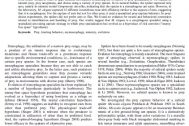Content
We investigated the trophic strategy of Mexcala elegans Peckham &
Peckham 1903, an ant-eating salticid spider from South Africa, in order to gain baseline information concerning the evolution of prey specialization. We studied its natural prey, prey acceptance, and choice using a variety of prey species. In its natural habitat, the spider captured only ants, mainly its mimetic model Camponotus cinctellus, indicating that the species is a stenophagous ant-eater. However, in the laboratory, M. elegans captured 12 different invertebrate taxa with efficiency similar to the capture of ants, suggesting that it is euryphagous. For the capture of ants but not for other prey, it used a specialized prey-capture behavior. In preychoice experiments, the spiders did not prefer ants to flies. We found no evidence for neural and behavioral constraints related to identification and handling of prey. Our results suggest that M. elegans is a euryphagous specialist using a specialized ant-eating capture strategy in which prey specialization has evolved as a byproduct of risk aversion (‘‘enemyfree space’’ hypothesis).
Peckham 1903, an ant-eating salticid spider from South Africa, in order to gain baseline information concerning the evolution of prey specialization. We studied its natural prey, prey acceptance, and choice using a variety of prey species. In its natural habitat, the spider captured only ants, mainly its mimetic model Camponotus cinctellus, indicating that the species is a stenophagous ant-eater. However, in the laboratory, M. elegans captured 12 different invertebrate taxa with efficiency similar to the capture of ants, suggesting that it is euryphagous. For the capture of ants but not for other prey, it used a specialized prey-capture behavior. In preychoice experiments, the spiders did not prefer ants to flies. We found no evidence for neural and behavioral constraints related to identification and handling of prey. Our results suggest that M. elegans is a euryphagous specialist using a specialized ant-eating capture strategy in which prey specialization has evolved as a byproduct of risk aversion (‘‘enemyfree space’’ hypothesis).



